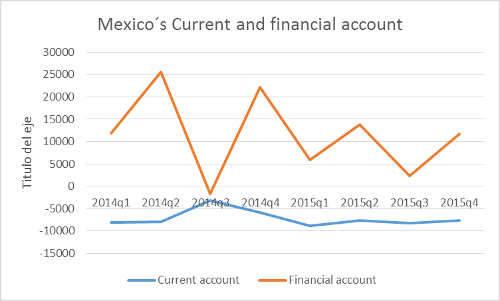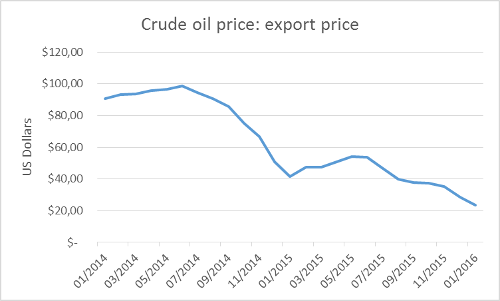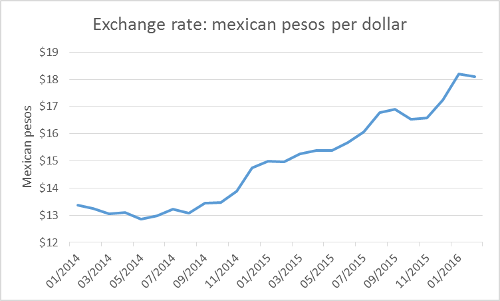No End in Sight for Mexico’s Trade Deficit

By Edgar Ortiz March 31, 2016
Translated from Spanish by Robert Goss
The news about the fall in oil prices and the impact it has had on oil producing countries is nothing new. For Mexico, this fall has had a rather notable effect on local currency exchange rates, and in spite of the depreciation of the peso, exportations have not risen.
The following graph gives us some insight on Mexico’s financial and trade balances since 2014.
Using data from 2016, we see that tendencies do not seem to have changed. According to the most recent INEGI report (Mexican National Institute of Statistics and Geography), in January of this year, Mexico had closed with a 3.44 billion dollar trade deficit compared with a deficit of 3.26 billion dollars in the same month in 2015.
During this same time period, the only sector that had showed any increase in exportations was the auto industry which saw a 1.8% increase. On average, other non-oil exportation generally saw a 0.38% decrease in exportations which isn’t exactly promising for Mexico’s economy. The largest fall in exportations was seen by the oil market with a 49% decrease in January of 2016 when compared to January or the previous year. The following graph demonstrates the performance over time of Mexico’s oil export price since 2014.
The correlation between the fall in oil prices and the foreign exchange seems to show that the peso largely owes its depreciation to the trade deficit.
Mexico has maintained its currency exchange relatively low mainly due to the trade deficit, and while the Bank of Mexico has conducted foreign exchange trading in order to prevent drastic fluctuations in the exchange rate, it has still lost about 3% in foreign exchange reserves in relation to M2 between 2014 and 2016. This loss does not seem significant enough to deem to be so important.
What we can take away from this is that the Bank of Mexico has taken cautious measures and has handled its monetary policy with relative success. However, as mentioned above, the real problem for the economy of Mexico is that the non-oil exportations have slowly decreased and this has happened in spite of the relative benefit that the depreciated peso should have provided. This alone demonstrates that what is most important to an economy is real competitiveness as opposed to exchange rate competitiveness.
We can only hope that once the foreign exchange rate ceases to drop, capital will begin to pour into Mexico. The only latent risk for Mexico is that public debt has risen at a rapid rate, thus as mentioned in Mexico’s 2015 2nd semester report.
Get our free exclusive report on our unique methodology to predict recessions

Edgar Ortiz
Edgar Ortiz has a degree in Law from the Francisco Marroquín University. He holds a master in Austrian Economics at the Rey Juan Carlos University in Madrid. He is the executive director of the Center of Economic and Social Studies (CEES). He is a professor of economics at the Francisco Marroquín University, and he is also an analyst on issues related to the situation at Canal Antigua. He works as an associate lawyer at Estudio Jurídico Rivera.
Get our free exclusive report on our unique methodology to predict recessions





